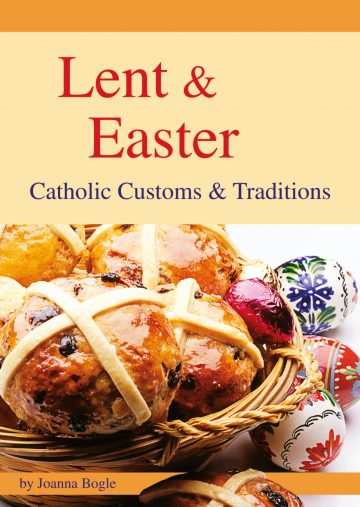Jesus Christ is risen today, Alleluia!
Our triumphant holy day, Alleluia!
Who did once upon the cross, Alleluia!
Suffer to redeem our loss. Alleluia!
Hymns of praise, then, let us sing, Alleluia!
Unto Christ, our praises bring, Alleluia!
Who endured the cross and grave, Alleluia!
Sinners to redeem and save. Alleluia!
(Easter hymn)
Although the Easter Vigil is one of the most magnificent events in the Church’s year and attendance obviously fulfils the Sunday Mass obligation, there is something special about going to Mass on Easter Sunday morning.
“But on the first day of the week, at early dawn, they went to the tomb, taking the spices which they had prepared. And they found the stone rolled away from the tomb, but when they went in they did not find the body. While they were perplexed about this, behold, two men in white stood by them in dazzling apparel; and as they were frightened and bowed their faces to the ground, the men said to them: ‘Why do you seek the living among the dead? He is not here, but has risen’”. (Lk 24:1-6)
The hymns at Mass will be full of joy and “alleluias”. The altar will be surrounded by flowers and candles. The Gospel will tell the glorious story of the Resurrection, the empty tomb, Mary Magdalene and the Apostles.
“Easter is not simply one feast among others, but the “Feast of feasts”, the ‘Solemnity of solemnities’ just as the Eucharist is the ‘Sacrament of sacraments’.” (Catechism of the Catholic Church 1169)
Easter egg hunt
An Easter egg hunt is the traditional activity for Easter morning. There are lots of different ways of doing this: having a large number of very small chocolate eggs – the kind that you buy by the bagful – is best, because they can be hidden in so many unexpected places and take a long time to find. You can put one into the heart of a daffodil, behind a clock, or have two or three in a line on top of a picture. There can also be larger chocolate eggs, and perhaps one or two of the plastic and cardboard sort that have a small gift or sweets inside. Every egg-hunter should have a decorated bag or basket. You can make the hunt fairer by giving each child a specific colour for which to hunt. Sometimes an egg-hunt can be organised with clues like a treasure-hunt.
Hunting for eggs is a very old custom, and obviously related to the simple reality of free-range hens tending to lay their eggs in all sorts of different places. It has a Christian link in the notion of Mary Magdalene in the garden, looking for Christ, “They have taken away my Lord, and I know not where to find him”. Modern commentators tend to say that the eggs are laid by the Easter Bunny, but this is a bit unconvincing since rabbits don’t lay eggs. The custom goes back much further than the modern commercialised Easter Bunny image (though that doesn’t mean that chocolate bunnies can’t be enjoyed at Easter too). No one seems to know how the Easter Bunny originated. Rabbits are associated with fertility – and of course lots of baby bunnies are born at this time of year. An Easter cake decorated with chocolate rabbits can be part of the Easter celebrations, and you can also buy jelly-moulds in rabbit-shapes.
Egg rolling
Another enjoyable Easter tradition is egg-rolling. No one seems to know the origin of this, but many seem to agree that it might be the rolling away of the stone from the mouth of the tomb of the risen Christ. You take your Easter eggs to a park or garden where there is a hillside or slope, and roll them downhill. Only when they hit one another or a stone or other obstacle, and crack open can they be eaten. (Tip: seal the silver-paper wrappers of the eggs with lots of sellotape before you start egg-rolling, otherwise the wrappers come off and you get smashed chocolate over the hillside and nothing to eat!). Some places have egg-rolling races and competitions. If there isn’t one in your area, why not start one?
Easter lamb
The traditional dish for Easter Sunday lunch is roast lamb, into which spears of rosemary have been stuck. Rosemary is identified with the “bitter herbs” mentioned in the book of Exodus as part of the Passover meal.
Simnel cake
Simnel cake, associated with Mothering Sunday, is also traditionally eaten on Easter Sunday. A recent popular addition to the tea-table is small “nests” made of chocolate crispy-cakes (made by mixing melted chocolate with cornflakes, forming the mixture into small cakes and then leaving them to set) with two or three small sugar eggs inside. You can also have Easter biscuits, made in the shapes of eggs, Easter lambs, or Easter rabbits.
 This blog is extracted from our ebook Lent and Easter. This booklet describes the rich heritage of customs and traditions long practiced by Catholics down the ages, up to today and how the liturgy in turn enriches their meaning.
This blog is extracted from our ebook Lent and Easter. This booklet describes the rich heritage of customs and traditions long practiced by Catholics down the ages, up to today and how the liturgy in turn enriches their meaning.
Download Lent and Easter from your preferred ebook platform.


